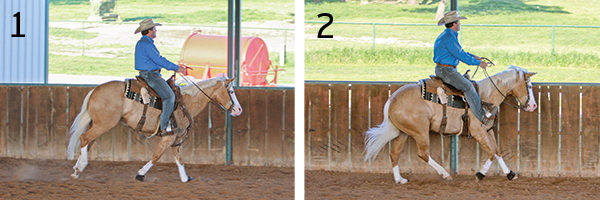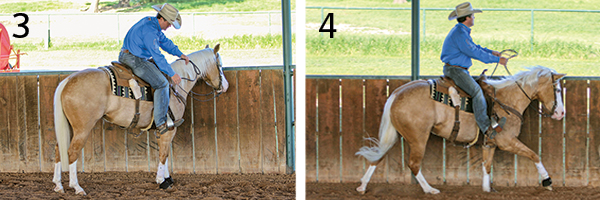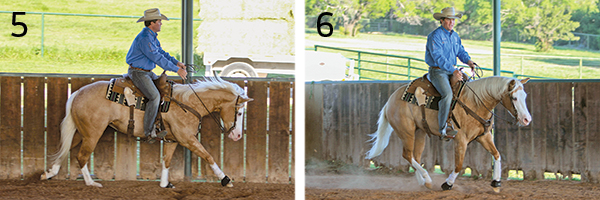Let’s be honest: Lead changes ignite anxiety in almost all amateur riders. But if you can teach your young horse to change leads with ease early in the training process, you’ll save yourself time, frustration, and raw nerves in the long run.
Lead changes come naturally to a horse. You might not see him run to a sliding stop or spin four times in a pasture, but I bet you’ve seen your horse change leads when he’s running and playing. I use my horse’s natural instinct to change leads and add in my cues so that it becomes second nature in the arena, just like in the pasture.
I’ll outline my steps for teaching a left-to-right lead change on one of my 3-year-old mares; switch the instructions to go from right to left. Outfit your horse in a bit that minimizes interference from you and enables your horse to stay straight. Ride with two hands on the reins so you can control each part of your horse. Advance to one-handed riding when you feel confident that your horse understands what you want.
1. Before I begin, I check my horse’s steering. When I lay a rein across her neck, her feet should move away from that pressure and her shoulders should follow my hand. She also should move away from calf pressure. To start the lead-change work, I lope a left-lead circle. When my horse is responsive, I transition my loping circle to a straight diagonal line toward about where the third cone would be in a reining pattern (about ⅔ of the way down the arena). Straightness is key in this approach to the fence. I keep my eyes up and my shoulders and hips squarely pointed to the left of my spot on the fence. This helps my horse stay in her left lead and keep her body straight.

2. I ride all the way up to the fence, which lets me use my horse’s natural instinct to change leads. She wants to switch directions to avoid the fence. I keep my upper-body position the same as during my approach—facing just to the left of my 45-degree angle approach. (It’s shown in the photo on page 31.) My hands stay above my horse’s mane line, reinforcing that 45-degree angle to the wall. This helps me stay out of my horse’s way (something we’ll discuss in Photo 4) and helps her stay straight in the approach to the wall.
3. Obviously, this is exaggerated, but it shows how I get in my horse’s way if I change my body position too soon. If I let my body and hands go to the right before my horse changes leads and directions, I’m blocking her from getting the lead change. Staying a little to the left of the 45-degree angle to the fence helps give my horse the
space and freedom of movement she needs to achieve the lead change.

4. When we get to the wall, I change my leg pressure. I take my right leg off and put on my left leg. This helps “trip” the lead change, along with the inches-away fence. Once she’s changed to the right lead, we continue on a circle to the right. If my horse doesn’t change leads, it’s no big deal. I have three other arena walls I can lope toward to try it again. I’ll keep my horse in a counter-canter and find the next opportunity to lope toward the fence at a 45-degree angle and try the same steps again. Lead changes can try your patience if you’re not in the right mindset to work on them. There’s never a time when losing patience benefits you in training a horse. Never get into a battle with your horse over a lead change. Once you scare the horse, it’s difficult to go back and undo that damage.
5. We got the change to the right lead. As soon as that happens, I alter my body position to follow along with my horse’s change of direction and bring my hands down to guide her along a circle to the right.

6. When I first teach this exercise, I use my horse’s anticipation of changing leads to my advantage. I want her to think about it, and if she changes early it’s no big deal. But once she gets the steps of the exercise and starts to think “I know it’s coming,” I switch it up and have her softly counter-canter through where we’d change leads and onto another circle. I don’t start to ask for a change in the middle of the arena, as I would during a pattern, until the horse is going to be shown. I don’t ever want to ask for a lead change in the middle of the arena if my horse isn’t 100-percent in lead changes anywhere else I ask in the arena.
Casey Deary, Weatherford, Texas, had his most recent big wins at the 2016 NRHA Derby and the 2015 NRHA Futurity. In 2015, he joined the NRHA’s Million Dollar Rider roster. Casey and his wife, Nicole, have four children. Learn more at dearyperformance.com.






